10 endangered species in Malaysia
Malayan Tiger, Malayan Tapir, Malayan Peacock-Pheasant
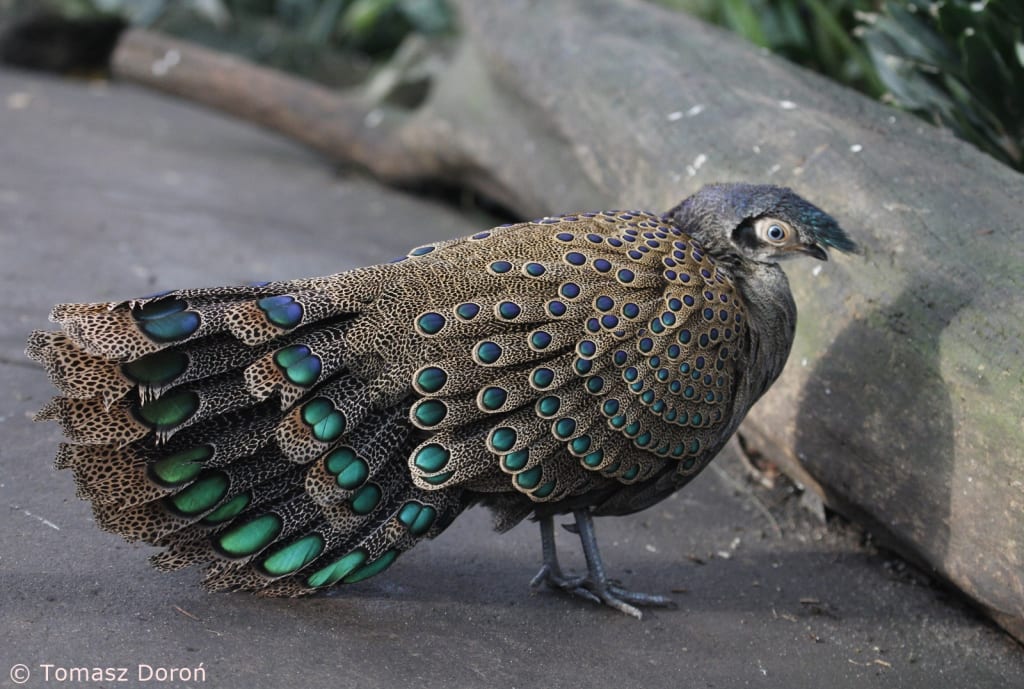
1., Malayan Tiger (Panthera tigris jacksoni):
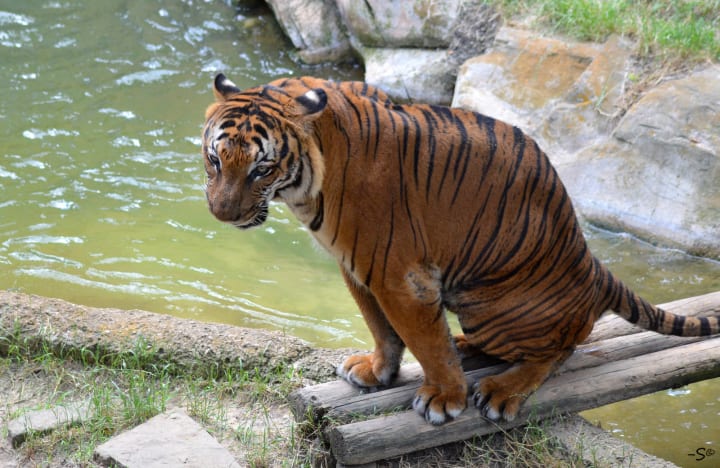
The Malayan tiger (Panthera tigris jacksoni) is a critically endangered subspecies of tiger that is native to the southern and central parts of the Malay Peninsula. Also known as the Malaysian tiger, it is one of the smallest tiger subspecies and has a unique genetic lineage.
Here are some key details about the Malayan tiger:
Appearance: Malayan tigers have a striking appearance with a short, reddish-orange coat and dark, vertical stripes that help them blend into their forest habitat. They have a white belly and white spots on their ears, which are believed to serve as a form of communication.
Size and Weight: Adult male Malayan tigers can grow up to 2.5 meters (8.2 feet) in length, excluding the tail, which can measure an additional 0.7 meters (2.3 feet). They typically weigh between 120 to 140 kilograms (265 to 310 pounds). Female tigers are slightly smaller, measuring around 2.3 meters (7.5 feet) in length and weighing between 100 to 110 kilograms (220 to 240 pounds).
Habitat: Malayan tigers primarily inhabit the lowland and montane forests of the Malay Peninsula. They require a range of habitat types, including areas with dense vegetation for hunting and territories that provide access to water sources.
Diet: Tigers are carnivorous predators and the Malayan tiger is no exception. Its diet consists mainly of ungulates such as sambar deer, barking deer, and wild boar. Occasionally, it may also prey on smaller animals like birds, monkeys, and reptiles.
Behavior: The Malayan tiger is a solitary and territorial animal. Males typically have larger territories, which they mark with scent markings and vocalizations to communicate their presence to other tigers. They are primarily active during the night and have excellent hunting skills, aided by their strong jaws and sharp claws.
Conservation Status: The Malayan tiger is classified as critically endangered by the International Union for Conservation of Nature (IUCN). It faces numerous threats including habitat loss, fragmentation, poaching, and illegal wildlife trade. The estimated population of Malayan tigers in the wild is believed to be less than 200 individuals, making them one of the most endangered tiger subspecies.
Conservation Efforts: Malaysia has implemented various conservation initiatives to protect the Malayan tiger. This includes the establishment of protected areas, strengthening anti-poaching efforts, and promoting public awareness about the importance of tiger conservation. Additionally, collaborations with international organizations and conservation projects have been established to address the threats faced by the species.
2., Sumatran Rhinoceros (Dicerorhinus sumatrensis):
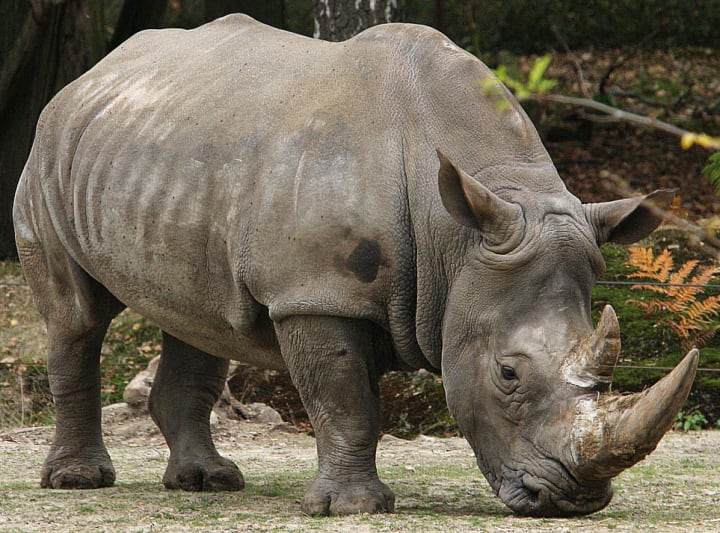
The Sumatran rhinoceros (Dicerorhinus sumatrensis) is one of the most critically endangered rhinoceros species in the world. It is native to the dense rainforests of Sumatra and Borneo, including the Malaysian states of Sabah and Sarawak. Here are some comprehensive details about the Sumatran rhinoceros:
Appearance: The Sumatran rhinoceros is the smallest rhinoceros species, measuring about 1.2 to 1.4 meters (4 to 4.6 feet) in height at the shoulder. It has a characteristic reddish-brown to dark gray skin, which is covered in coarse, bristly hair. Unlike other rhinoceros species, the Sumatran rhinoceros has two small horns, with the front horn being longer and more prominent.
Population and Distribution: The population of Sumatran rhinoceroses has drastically declined over the past century due to habitat loss and poaching. It is estimated that fewer than 80 individuals remain in fragmented populations across Sumatra and Borneo. In Malaysia, their presence is primarily limited to the Danum Valley Conservation Area in Sabah.
Habitat: Sumatran rhinoceroses inhabit tropical rainforests and dense mountainous regions. They are known to inhabit both lowland and highland areas, typically ranging between 600 to 1,500 meters (1,970 to 4,920 feet) in elevation. These rhinoceroses require access to mud wallows and natural water sources for bathing and cooling their bodies.
Diet: Sumatran rhinoceroses are herbivorous and mainly feed on a variety of plants, including leaves, twigs, fruits, and bark. They have a complex digestive system that allows them to efficiently extract nutrients from fibrous vegetation.
Behavior: Sumatran rhinoceroses are primarily solitary animals, with males and females coming together only during mating periods. They are known for their shy and elusive nature, often avoiding human contact. These rhinoceroses have a prehensile upper lip that they use to grasp and pull vegetation into their mouths.
Reproduction: The gestation period for Sumatran rhinoceroses is approximately 15 to 16 months, making it the longest gestation period among all mammals. Females give birth to a single calf, which remains dependent on its mother for an extended period. The mother provides care and protection to her calf until it reaches maturity.
Conservation Status: The Sumatran rhinoceros is classified as critically endangered by the International Union for Conservation of Nature (IUCN). It faces a multitude of threats, including habitat loss due to deforestation, illegal poaching for its horn, and a low reproductive rate. Conservation efforts, including captive breeding programs and habitat protection, are being implemented to prevent the extinction of this species.
3., Bornean Orangutan (Pongo pygmaeus):
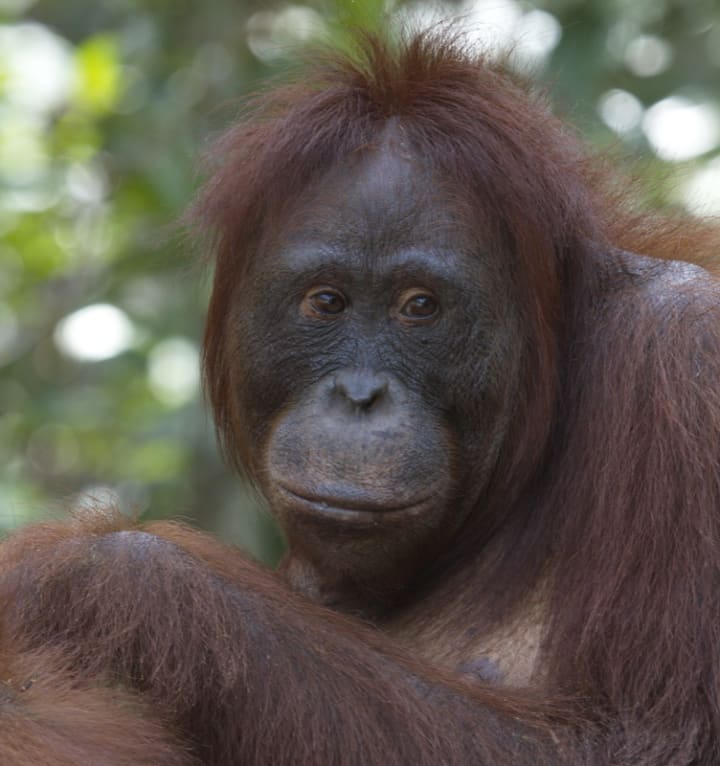
The Bornean orangutan (Pongo pygmaeus) is a critically endangered species of great ape found exclusively on the island of Borneo. Known for their intelligence and gentle nature, Bornean orangutans are remarkable creatures. Here are comprehensive details about them:
Appearance: Bornean orangutans are large primates with a distinctive reddish-brown coat of fur. Adult males typically have a larger body size than females, reaching heights of up to 1.5 meters (4.9 feet) when standing upright. They have long, powerful arms and a heavier build compared to other great ape species.
Distribution and Habitat: Bornean orangutans are native to the island of Borneo, which includes parts of Malaysia, Indonesia, and Brunei. They primarily inhabit lowland rainforests, swamp forests, and montane forests. Their range extends from the northern tip of Borneo down to central and southern regions.
Diet: Bornean orangutans are predominantly herbivorous, with a diet consisting mainly of fruits, leaves, bark, and occasionally insects. They have a unique ability to digest a variety of plant materials, including the tough inner bark of trees.
Behavior: Orangutans are primarily arboreal, spending most of their time in trees. They are solitary animals, with males typically having larger home ranges that overlap with multiple female territories. They are known for their impressive climbing and swinging abilities, using their long arms and hook-like hands to move through the forest canopy.
Intelligence and Tool Use: Bornean orangutans are renowned for their intelligence. They exhibit problem-solving skills, use tools to extract food, and display a remarkable ability to learn. They have been observed using branches as tools for digging, swatting insects, and extracting seeds from fruits.
Reproduction: Female orangutans reach sexual maturity around 12 to 15 years of age, while males mature later at around 15 to 20 years. Females give birth to a single offspring after a gestation period of approximately 9 months. The young orangutan remains dependent on its mother for several years, learning important survival skills.
Conservation Status: Bornean orangutans are listed as critically endangered by the International Union for Conservation of Nature (IUCN). They face significant threats from habitat loss due to deforestation, illegal hunting, and the illegal pet trade. Their population has declined rapidly in recent decades, and it is estimated that fewer than 55,000 individuals remain in the wild.
Conservation Efforts: Conservation organizations and governments are actively working to protect Bornean orangutans and their habitats. Efforts include the establishment of protected areas, reforestation initiatives, law enforcement against poaching and illegal trade, and rehabilitation and reintroduction programs for orphaned and rescued orangutans.
4., Malayan Pangolin (Manis javanica):
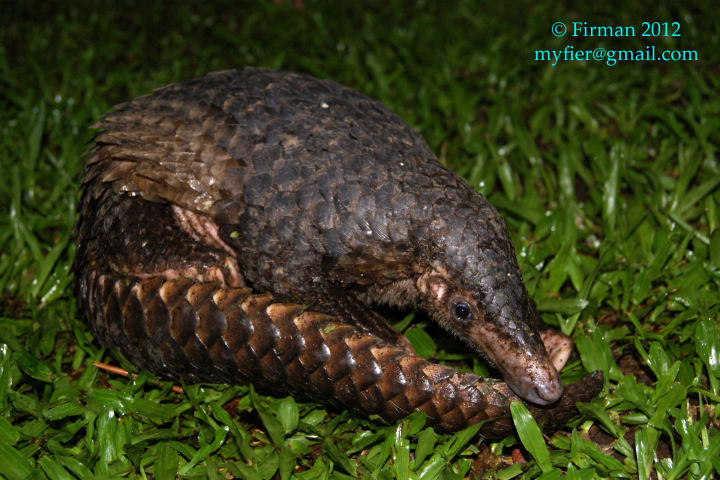
The Malayan pangolin (Manis javanica) is a critically endangered mammal species that belongs to the family Manidae. Also known as the Sunda pangolin or the Javan pangolin, it is native to Southeast Asia, including Malaysia. Here are comprehensive details about the Malayan pangolin:
Appearance: Malayan pangolins have a unique and distinctive appearance. They are covered in large, overlapping scales made of keratin, which is the same material found in human nails. The scales act as armor, protecting them from predators. They have a long snout, small eyes, and a prehensile tail. Their body coloration can range from pale yellow to dark brown.
Size: Malayan pangolins are relatively small in size compared to other pangolin species. They typically measure around 50 to 65 centimeters (20 to 26 inches) in length from head to tail, with a weight ranging between 5 to 7 kilograms (11 to 15 pounds). Males are generally larger than females.
Habitat: Malayan pangolins inhabit a variety of forested habitats, including lowland rainforests, secondary forests, and plantations. They can also be found in swampy areas and open grasslands. They are primarily ground-dwelling creatures but can climb trees proficiently.
Diet: Pangolins are insectivorous mammals, and their diet mainly consists of ants and termites. They have a long, sticky tongue that they use to extract insects from nests and mounds. The strong muscles in their stomach help them grind the tough exoskeletons of insects.
Behavior: Malayan pangolins are primarily nocturnal, meaning they are active at night. They are solitary animals and are known for their elusive nature. When threatened, they curl into a tight ball, tucking their head and tail under their scales for protection. This behavior makes them highly vulnerable to poaching.
Reproduction: Female Malayan pangolins give birth to a single offspring, called a pup. The gestation period is around 140 to 150 days. The pup clings to the mother's tail and eventually rides on her back as it grows. The young pangolin becomes independent after several months but may stay close to the mother for up to two years.
Conservation Status: The Malayan pangolin is classified as critically endangered by the International Union for Conservation of Nature (IUCN). It is one of the most heavily trafficked mammal species in the illegal wildlife trade due to the high demand for its scales and meat. Additionally, habitat loss and degradation contribute to the decline in their population.
Conservation Efforts: Various conservation organizations and governments are working to protect the Malayan pangolin. Efforts include strengthening law enforcement to combat illegal wildlife trade, raising awareness about their conservation status, and establishing protected areas to safeguard their habitats. Rehabilitation and release programs are also being implemented for rescued pangolins.
Protecting the remaining populations of Malayan pangolins and addressing the threats they face is crucial for their survival. Conservation efforts involve a combination of law enforcement, community engagement, habitat preservation, and efforts to reduce demand for pangolin products.
5., Malayan Tapir (Tapirus indicus):
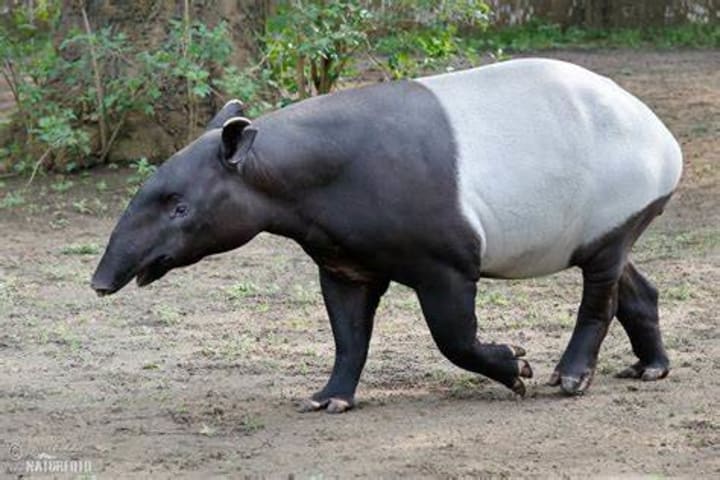
The Malayan tapir (Tapirus indicus) is an endangered mammal species native to the rainforests of Southeast Asia, including Malaysia. It is the largest of the five species of tapir and is known for its unique and distinctive appearance. Here are comprehensive details about the Malayan tapir:
Appearance: Malayan tapirs have a striking coloration pattern that distinguishes them from other tapir species. They have a black body with a white or light gray band that wraps around their midsection, extending from the shoulders to the rump. This pattern provides excellent camouflage in the dim light of the rainforest. Their face, ears, and lower legs are also black.
Size and Weight: Malayan tapirs are large mammals. They typically measure around 1.8 to 2.5 meters (6 to 8 feet) in length and stand approximately 90 to 110 centimeters (3 to 3.6 feet) tall at the shoulder. Adult tapirs can weigh between 250 to 400 kilograms (550 to 880 pounds).
Habitat: Malayan tapirs inhabit the dense tropical rainforests and swampy areas of Southeast Asia. They are primarily found in lowland areas, including floodplains and river valleys. They require access to water sources, such as rivers and mud wallows, for bathing and thermoregulation.
Diet: Tapirs are herbivorous animals with a diet consisting mainly of leaves, shoots, fruits, and aquatic vegetation. They use their long, flexible snout to grab and manipulate food. Tapirs are important seed dispersers in their ecosystems, as undigested seeds are passed through their digestive system and deposited in different areas.
Behavior: Malayan tapirs are primarily nocturnal, meaning they are most active during the night. They are solitary animals and are generally shy and elusive. Tapirs have a strong sense of smell and excellent swimming abilities, enabling them to navigate through water bodies and escape predators.
Reproduction: Female tapirs reach sexual maturity at around three to four years of age, while males reach maturity later, at around four to five years. The gestation period for Malayan tapirs is approximately 13 months. Females give birth to a single calf, which has a brown coat with white spots and stripes for camouflage. The mother cares for and protects the calf until it becomes independent after about a year.
Conservation Status: The Malayan tapir is classified as endangered by the International Union for Conservation of Nature (IUCN). They face significant threats from habitat loss due to deforestation, illegal hunting, and fragmentation of their habitat. The remaining population is estimated to be less than 2,500 individuals.
Conservation Efforts: Conservation initiatives focus on protecting the remaining habitats of Malayan tapirs and raising awareness about their conservation status. Efforts include establishing protected areas, promoting sustainable land-use practices, combating illegal hunting, and implementing captive breeding programs.
6., Malaysian Giant Turtle (Orlitia borneensis):
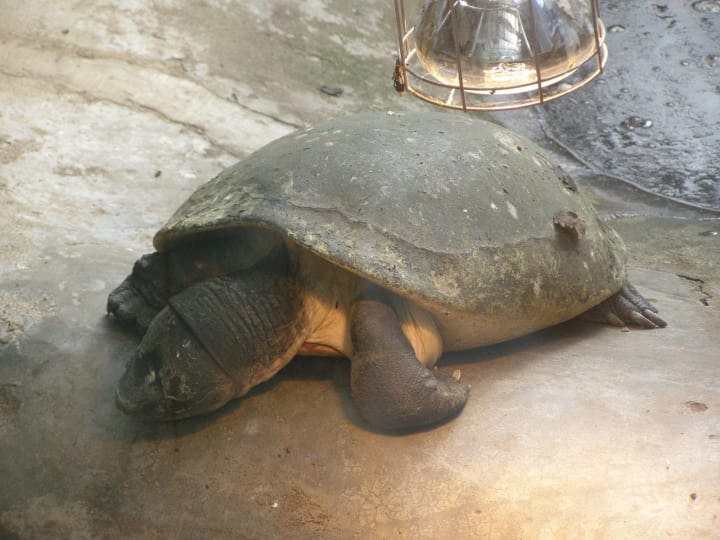
The Malaysian Giant Turtle, scientifically known as Orlitia borneensis, is a species of freshwater turtle native to Malaysia and Indonesia. It is one of the largest freshwater turtle species in the world and is highly regarded for its impressive size and unique physical characteristics. Here are some full details about the Malaysian Giant Turtle:
Taxonomy:
Kingdom: Animalia
Phylum: Chordata
Class: Reptilia
Order: Testudines
Family: Bataguridae
Genus: Orlitia
Species: Orlitia borneensis
Physical Description:
Size: Adult Malaysian Giant Turtles can reach an impressive size, with males typically growing larger than females. Males can attain a carapace length of up to 70 centimeters (27.5 inches) and a weight of around 35 kilograms (77 pounds), while females are slightly smaller.
Carapace: The carapace, or the upper shell, is dark brown to black in color and features a highly domed shape. It is relatively smooth and has a rough texture near the edges. The carapace is composed of large scutes (scales) and has a lengthwise ridge running down the center.
Plastron: The plastron, or the lower shell, is cream-colored to yellowish and is usually larger than the carapace. It consists of scutes that are more uniform in size compared to the carapace.
Head and Limbs: The head is large and triangular, with a blunt snout. The Malaysian Giant Turtle has powerful jaws and a hooked upper jaw. The limbs are strong and equipped with large claws, allowing them to navigate their natural habitat effectively.
Sexual Dimorphism: Males of the species can be distinguished from females by their longer and thicker tails, which extend beyond the carapace. Additionally, males tend to have a concave plastron, while females have a flat or slightly convex plastron.
Habitat and Distribution:
The Malaysian Giant Turtle is primarily found in freshwater habitats, such as rivers, streams, and lakes, with slow-moving or stagnant water. It is known to inhabit areas with dense vegetation, submerged logs, and muddy bottoms.
This species is native to Malaysia, specifically the rivers and wetlands of Sarawak and Sabah on the island of Borneo. It is also found in some parts of Indonesia, including Kalimantan (Indonesian Borneo) and Sumatra.
Behavior and Diet:
Malaysian Giant Turtles are predominantly herbivorous, feeding on a variety of aquatic vegetation, including algae, water plants, and submerged leaves. However, they may also consume small invertebrates and carrion opportunistically.
They are generally docile and shy in nature, often seeking refuge in the water when approached or threatened. They are primarily active during the day and bask on exposed logs or riverbanks to regulate their body temperature.
Reproduction:
Breeding in the Malaysian Giant Turtle typically occurs during the rainy season. Females will lay their eggs in sandy riverbanks, constructing nests in which they deposit their eggs. A typical clutch can consist of 10-20 eggs.
The incubation period ranges from 60 to 80 days, after which the hatchlings emerge and make their way to the water. Like many other turtle species, the sex of the hatchlings is determined by the temperature during incubation, with warmer temperatures resulting in females and cooler temperatures producing males.
Conservation Status:
The Malaysian Giant Turtle is listed as Endangered by the International Union for Conservation of Nature (IUCN) due to habitat loss, overexploitation, and illegal trade for its meat and eggs
7., Storm's Stork (Ciconia stormi):
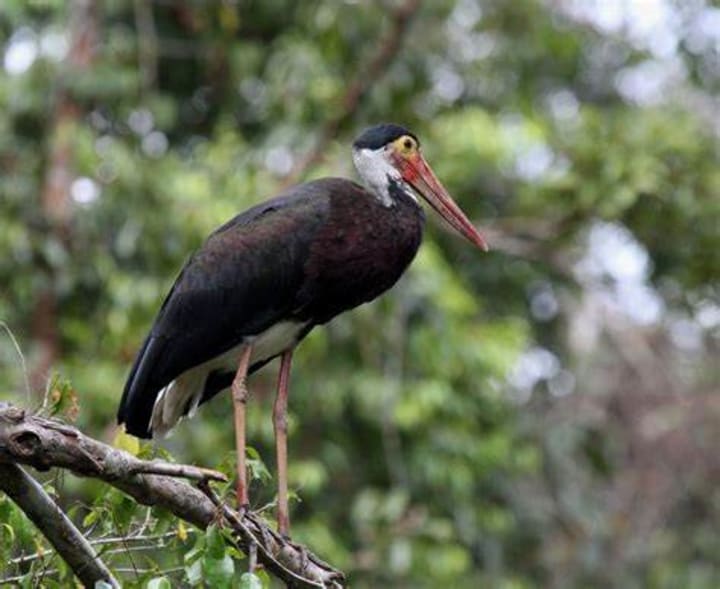
Storm's Stork, scientifically known as Ciconia stormi, is a majestic bird belonging to the Ciconiidae family. It is a large, wading bird found in Southeast Asia. Renowned for its striking appearance and unique features, the Storm's Stork is an important species in the region. Here are full details about Storm's Stork:
Taxonomy:
Kingdom: Animalia
Phylum: Chordata
Class: Aves
Order: Ciconiiformes
Family: Ciconiidae
Genus: Ciconia
Species: Ciconia stormi
Physical Description:
Size: The Storm's Stork is one of the largest stork species, measuring approximately 75-97 centimeters (30-38 inches) in length. It has an impressive wingspan of about 180-200 centimeters (71-79 inches). The female is slightly smaller than the male.
Plumage: This stork has a predominantly black body with contrasting white underparts. Its head and neck are covered in bare, pinkish-gray skin, adorned with fine bristles. The legs are long and black.
Bill: One of the most distinctive features of the Storm's Stork is its enormous, thick bill. It is orange-red in color, sturdy, and slightly curved downward. The lower bill is longer than the upper one, providing the bird with a unique appearance.
Juvenile Plumage: Juvenile Storm's Storks have duller plumage compared to adults. They have a brownish-black body, and their bare head and neck lack the pinkish-gray coloration seen in adults.
Habitat and Distribution:
The Storm's Stork is endemic to Southeast Asia. It is found in lowland rainforests, mangroves, peat swamps, and flooded areas with dense vegetation. This species prefers areas near rivers, lakes, and wetlands.
Its distribution includes countries such as Malaysia, Indonesia, Brunei, and southern Thailand. It is particularly prevalent in Borneo and Sumatra.
Behavior and Diet:
Storm's Storks are diurnal birds, primarily active during the day. They are highly specialized feeders, preying on a variety of aquatic animals. Their diet mainly consists of fish, eels, amphibians, reptiles, crustaceans, and small mammals.
These storks are skilled hunters and typically forage in shallow water, using their long legs to wade through the water while searching for prey. They employ a slow and patient approach, striking quickly with their powerful bill to catch their target.
Breeding:
Storm's Storks are monogamous and form long-term pair bonds. Breeding occurs during the dry season when the water levels are lower. They build large nests, usually constructed on tall trees near water bodies.
Both male and female participate in nest construction. The nest is made of sticks and leaves, forming a sturdy platform. The female typically lays 2-3 eggs, and both parents take turns incubating the eggs for around 35-40 days.
Conservation Status:
The Storm's Stork is currently classified as Endangered by the International Union for Conservation of Nature (IUCN). Its population is declining due to habitat loss, deforestation, and degradation of wetlands. Additionally, it faces threats such as illegal hunting and disturbance near nesting sites.
Conservation efforts are crucial to protect the remaining populations of Storm's Stork, including habitat preservation, the establishment of protected areas, and raising awareness about the importance of this remarkable species.
8., White-Handed Gibbon (Hylobates lar):
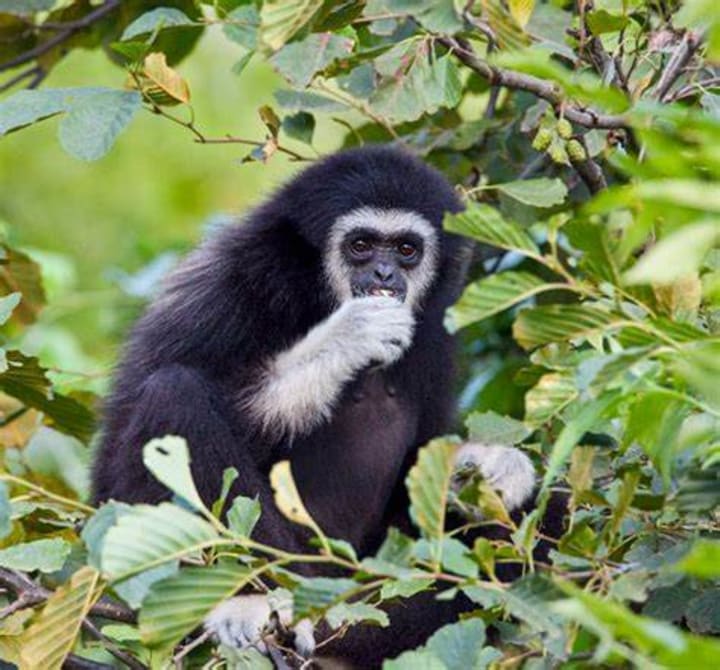
The White-Handed Gibbon, scientifically known as Hylobates lar, is a species of small ape native to Southeast Asia. It belongs to the family Hylobatidae and is renowned for its unique appearance, acrobatic skills, and melodic vocalizations. Here are full details about the White-Handed Gibbon:
Taxonomy:
Kingdom: Animalia
Phylum: Chordata
Class: Mammalia
Order: Primates
Family: Hylobatidae
Genus: Hylobates
Species: Hylobates lar
Physical Description:
Size: The White-Handed Gibbon is a small ape, with males and females displaying sexual dimorphism. Adult males measure approximately 45-64 centimeters (18-25 inches) in body length, excluding the tail, which adds an additional 50-65 centimeters (20-26 inches). Adult females are slightly smaller.
Coloration: The fur of the White-Handed Gibbon varies in color. Most individuals have a black or dark brown coat, while some populations in southern regions exhibit a lighter coloration, ranging from light buff to creamy white. Their hands and feet are white, which gives the species its common name.
Morphology: White-Handed Gibbons have a slender body with long limbs. Their arms are longer than their legs, aiding them in their arboreal lifestyle. They lack a tail, but their arms are highly adapted for swinging through trees, a movement called brachiation.
Sexual Dimorphism: Males and females of the White-Handed Gibbon display noticeable differences. Males have a throat sac, which enables them to produce loud vocalizations, and a white "cap" of fur on their head. Females lack these features.
Habitat and Distribution:
White-Handed Gibbons are found in the rainforests of Southeast Asia, including countries such as Thailand, Myanmar, Malaysia, Indonesia, and Laos. They primarily inhabit lowland and montane rainforests but can also be found in swamp forests and disturbed habitats.
Behavior and Diet:
White-Handed Gibbons are highly arboreal and spend most of their lives in the forest canopy. They are skilled brachiators, swinging from branch to branch using their long arms. They rarely descend to the ground, as they are not well-adapted for terrestrial movement.
These gibbons are diurnal and are known for their loud and melodious vocalizations. They use their calls to communicate and establish territories, with each mated pair having a distinct vocal duet.
Their diet mainly consists of fruits, leaves, flowers, and occasionally small invertebrates. They are well-suited for a frugivorous diet, thanks to their sharp incisors and complex digestive system that helps extract nutrients from plant matter.
Social Structure and Reproduction:
White-Handed Gibbons have a monogamous social structure, forming lifelong pair bonds. Mated pairs and their offspring make up a basic family unit. They are territorial, defending their range through vocalizations and physical displays.
Breeding can occur throughout the year, and females give birth to a single offspring after a gestation period of around seven months. The infant is cared for by both parents, and family members actively participate in its upbringing.
Conservation Status:
The White-Handed Gibbon is listed as Endangered by the International Union for Conservation of Nature (IUCN). The species faces significant threats, including habitat loss due to deforestation, illegal pet trade, and hunting. Conservation efforts focus on protecting their forest habitats, enforcing legislation against hunting and trafficking, and raising awareness about the importance of conserving these remarkable
9., Malayan Peacock-Pheasant (Polyplectron malacense):
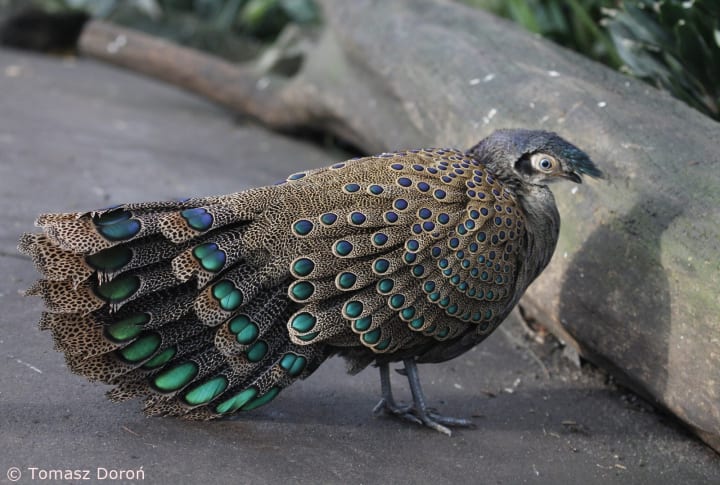
The Malayan Peacock-Pheasant (Polyplectron malacense) is a striking bird belonging to the family Phasianidae, which includes pheasants, quails, and partridges. It is also known as the Malacca Peacock-Pheasant or Malacca Peacock.
Physical Appearance:
The Malayan Peacock-Pheasant is a medium-sized bird with a distinct and beautiful plumage. The male and female birds have noticeable differences in appearance. The male has a dark blue-black body with metallic green and bronze feathers on its upperparts. The head is adorned with a prominent crest of elongated feathers. The breast and belly are black with small white spots, and the wings display striking iridescent blue and green ocelli, which are circular eyespots on the feathers. The tail is long and has a series of distinctive colorful eye-shaped patterns, for which the species is named.
In contrast, the female Malayan Peacock-Pheasant has a more subdued appearance. Her plumage is brown with intricate patterns of buff, black, and white feathers. She lacks the extravagant tail and crest seen in the males.
Habitat and Range:
The Malayan Peacock-Pheasant is endemic to the Malay Peninsula in Southeast Asia. It can be found in the lowland and hill forests of Malaysia and southern Thailand. The species prefers dense vegetation and understory habitats, particularly near streams and ravines.
Behavior and Diet:
This species is primarily terrestrial, spending most of its time on the ground. It is known to be shy and elusive, often hiding in dense vegetation to avoid predators and human disturbances. Malayan Peacock-Pheasants are generally solitary birds, but during the breeding season, males engage in elaborate courtship displays to attract females. These displays involve raising their crests, fanning out their tail feathers, and making various calls and vocalizations.
The diet of the Malayan Peacock-Pheasant consists mainly of fruits, seeds, insects, and other invertebrates found on the forest floor. They use their strong beaks to forage and scratch the leaf litter in search of food.
Conservation Status:
The Malayan Peacock-Pheasant is classified as "Vulnerable" by the International Union for Conservation of Nature (IUCN). The species faces significant threats due to habitat loss caused by deforestation, agricultural expansion, and logging activities. Additionally, they are sometimes hunted for their meat and feathers, further contributing to their decline.
Conservation efforts are crucial to protect the remaining populations of the Malayan Peacock-Pheasant. This includes establishing protected areas, raising awareness about the species, and promoting sustainable forest management practices to preserve their habitat.
Overall, the Malayan Peacock-Pheasant is a captivating and unique bird species with its intricate plumage and elusive behavior. Its conservation is of utmost importance to ensure the survival of this stunning bird in the wild.
10., Painted terrapin (Batagur borneoensis):
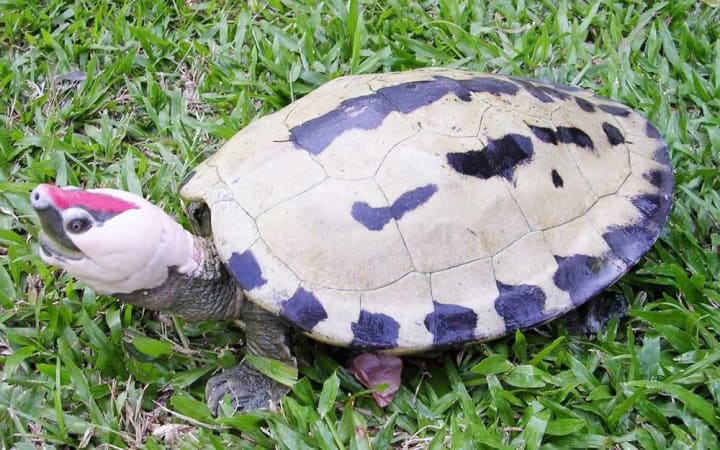
The Painted Terrapin (Batagur borneoensis) is a critically endangered species of turtle belonging to the family Geoemydidae. It is also commonly known as the Borneo River Turtle or Bornean Terrapin.
Physical Appearance:
The Painted Terrapin is a medium-sized turtle with a relatively flat, oval-shaped shell, known as a carapace. The carapace is dark brown to black in color, with light yellow or cream-colored markings. These markings vary in pattern and can be irregular lines, spots, or streaks, giving the turtle its distinctive "painted" appearance. The underside of the shell, known as the plastron, is pale yellow. The head and limbs of the Painted Terrapin are also dark brown to black, and the legs have strong claws.
Habitat and Range:
The Painted Terrapin is native to the island of Borneo, which is shared by Malaysia, Indonesia, and Brunei. It inhabits freshwater rivers, streams, and tidal areas within mangrove forests. The species is semi-aquatic, spending time both in the water and on land. It relies on specific habitats with sandy or muddy riverbanks for nesting.
Behavior and Diet:
Painted Terrapins are primarily aquatic and are well-adapted to life in water. They are good swimmers and have webbed feet for efficient propulsion. However, they also venture onto land, especially females during the nesting season.
These turtles are omnivorous and have a varied diet. They primarily feed on aquatic plants, leaves, fruits, and seeds found in their habitat. They also consume small invertebrates, such as insects, snails, and crustaceans.
Conservation Status:
The Painted Terrapin is listed as "Critically Endangered" by the International Union for Conservation of Nature (IUCN). It is one of the most endangered turtle species globally and faces severe threats to its survival.
The main reasons for the decline of Painted Terrapin populations are habitat destruction and fragmentation due to the conversion of riverine habitats for agriculture, aquaculture, and urban development. Egg collection for consumption and illegal pet trade also pose significant threats to the species. Additionally, pollution, water pollution, and incidental capture in fishing gear further contribute to their decline.
Conservation efforts are being undertaken to protect the Painted Terrapin. These efforts include establishing protected areas, implementing strict regulations against egg collection and trade, community-based conservation initiatives, and raising public awareness about the importance of preserving this species.
Overall, the Painted Terrapin is an incredibly unique and beautiful turtle species endemic to Borneo. Urgent conservation actions are necessary to prevent the extinction of this critically endangered species and to preserve the ecological integrity of its freshwater habitats.
About the Creator
Enjoyed the story? Support the Creator.
Subscribe for free to receive all their stories in your feed. You could also pledge your support or give them a one-off tip, letting them know you appreciate their work.






Comments (1)
It is deeply concerning to see that so many species in Malaysia are facing the threat of extinction.